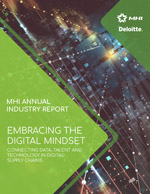MHI Annual Industry Report, Surprises and Good News
Print this Article | Send to Colleague

If you were still a little sleepy when getting to the Thomas Murphy Ballroom on Wednesday morning, that feeling probably didn’t last long. The magnitude and surprises in the information shared and the amount of intellect that was exhibited and shared by the panelists provided more of a mental jolt than any amount of coffee could accomplish.
But, first the good news shared by MHI CEO George W. Prest: “Despite all the news, there has been a lot of energy on the floor… We have had better-than-expected attendance.”
And the attendees who got out of bed a little earlier so they could listen to the 8:45 AM “Preview the 2020 MHI Annual Industry Report” were in for a treat – or more like an entire piñata of tasty news bites – from Prest and the panel: Randy V. Bradley, Assistant Professor of Information Systems and Supply Chain Management, Haslam College of Business, The University of Tennessee; Arpana Brahmbhatt, US Industry Solutions - Manufacturing, Microsoft; Rick Faulk, CEO, Locus Robotics; and Thomas Boykin, Supply Chain Specialist Leader, Deloitte.
The introduction to the report findings by Boykin revealed some surprises this year. Finding out whether companies have adopted or plan to adopt the 11 technologies detailed in the report and in which order is always one of the most interesting aspects, said Boykin. For example, predictive analytics are skyrocketing in expected adoption rates and sensors and automatic identification are supposed to reach 68% in the next 1-2 years. Another interesting aspect of the report is the degree to which companies expect these technologies to impact the supply chain, he added. For example, robotics went from fifth to first this year.
But it is no single technology alone that will make the biggest impact. “Both data and technology are what is driving and will empower the supply chain of the future,” said Boykin.
That is one of the reasons why establishing a source of good data is imperative. As Bradley put it, “Data is the new oil” as far as being a valuable resource. “The challenge is we don’t have a good way of evaluating data,” he added. “We don’t have a scarcity of data. We have a scarcity of good data.” And once you have that data, you need to know how to use it. Leveraging the data you have and empowering your frontline has evident ROI in many areas, said Brahmbhatt.
According to the report, the greatest challenge for companies (57%) remains the same: hiring and retaining qualified workers. Companies are starting to change how they find talent, though. They are starting to focus on talents instead of skill sets, said Boykin. “Talent is malleable,” explained Bradley. Also, 30% are reskilling their workforce, according to the report.
Training is also changing and companies are coming up with innovative ways to be better at this. Faulk said they are using data to help with training. Workers are wearing Bluetooth tags to track their paths. Then, the company is posting the digital path of the best picker and the path of the worst picker and displaying those paths on a big Jumbotron in the warehouse. “We track the footsteps and we use that for training improvement,” said Faulk. “Technology is making these jobs more efficient.”
Innovation is also showing itself when it comes to proactive planning. Bradley said, “We are anticipating the needs of the consumer rather than waiting for the order to come through.” The biggest inhibitor is the ability to imagine what you think is not possible. “You have to set a line in the sand and figure out how you are going to get there,” he said.
Part of figuring out how to get there is having a “clear, articulated” digital strategy, said Bradley. Conveniently, a DCI Toolkit was introduced in the report this year to help users do exactly that. It will help companies measure, adapt and develop a Digital Consciousness Index plan. Bradley also recommended evaluating whether you are innovating for your customers or just for the sake of being innovative. His third tip was that when it comes to finding talent, the “tried and true” approaches don’t really work in the area. Be innovative!
Perhaps Prest summed it up best when he said, “Innovation comes from failure. Failure is the opportunity going forward.”
For more details on the Industry Report and to download a free copy, click here.

